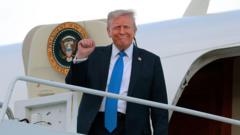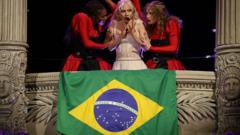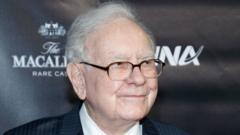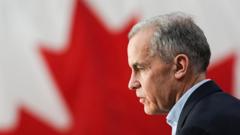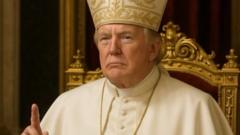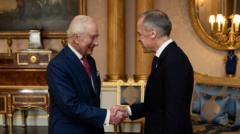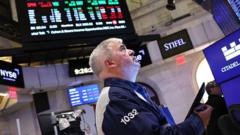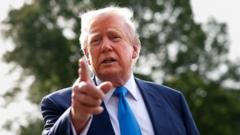Trump's return to power brings both populist fervor and significant challenges as he sets forth his agenda for the nation.
**A New Dawn for America: Trump's Inauguration Marks Second Era**
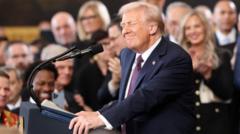
**A New Dawn for America: Trump's Inauguration Marks Second Era**
Donald Trump vows a "golden age" for the U.S. in an inaugural address filled with promises and controversial directives.
In an electrifying inaugural address, Donald Trump captured the attention of the nation as he began his second term as the 47th president of the United States. Positioned on the crest of widespread voter dissatisfaction, he heralded the commencement of a “golden age” for America, asserting his commitment to reshape the country's future. The day was characterized by a flurry of speeches, ad-lib remarks, and executive orders that kept the attention of supporters and critics alike.
Trump's inaugural address reflected a complex tapestry of promises intertwined with contradictions that capture the duality of his presidency. As he spoke for what seemed like hours, he outlined his vision for the new America while showcasing his unique blend of theatricality and controversy, energizing his base while earning the ire of others.
Central to Trump’s address were critical issues such as immigration and economic policies, which polls indicated resonated most with American voters during the past year. A notable moment came when he announced plans to abolish government-promoted diversity initiatives and reiterated a strict binary definition of gender, prompting roaring applause from his supporters.
However, before elaborating on his vision for the promised "golden age," Trump painted a bleak portrayal of the current political landscape. In front of a stone-faced former President Joe Biden and other Democrats, he declared there was a profound "crisis of trust" in government institutions and condemned what he deemed the "weaponization" of the Justice Department against him regarding the contested results of the 2020 election.
Reaffirming his anti-establishment sentiment, he lamented what he called the betrayals by a "radical and corrupt establishment." Still, Trump now occupies a position of considerable influence, flanked by some of the most affluent corporate leaders in the world.
With a commitment to pursue an aggressive agenda, Trump's aides readied a series of executive actions touching on immigration, energy, and cultural matters. He detailed plans for declaring national emergencies, deploying military forces to the borders, and opening federal lands to energy extraction. His comments suggesting rebranding the Gulf of Mexico and regaining control over the Panama Canal hinted at provocative foreign policy ambitions.
Throughout the course of his day, Trump oscillated between formal rhetoric and more off-the-cuff, spontaneous remarks, reminiscent of his earlier presidency. Allegations of electoral fraud and personal attacks on former political opponents defined his public statements as he addressed supporters both at the Capitol and subsequent events.
The signing of executive orders transformed habitual presidential duties into spectacles, showcasing a determination to rescind previous policies while theatrically engaging with the crowd. Trump’s actions, including regulatory freezes and symbolic gestures aimed at ending government overreach, reinforced his combative approach to leadership.
As the day progressed, Trump’s unpredictability continued to shine through; whether making bold pledges about tariffs or sparking controversies regarding citizenship for children of undocumented immigrants, he kept everyone guessing.
As he launches into his second term, Trump is met with the dual challenge of fulfilling his grand vision while navigating the unpredictable nature of his political persona. The stage is set, and the next chapter of American governance has begun under the bold, if contentious, leadership of Donald Trump.
Trump's inaugural address reflected a complex tapestry of promises intertwined with contradictions that capture the duality of his presidency. As he spoke for what seemed like hours, he outlined his vision for the new America while showcasing his unique blend of theatricality and controversy, energizing his base while earning the ire of others.
Central to Trump’s address were critical issues such as immigration and economic policies, which polls indicated resonated most with American voters during the past year. A notable moment came when he announced plans to abolish government-promoted diversity initiatives and reiterated a strict binary definition of gender, prompting roaring applause from his supporters.
However, before elaborating on his vision for the promised "golden age," Trump painted a bleak portrayal of the current political landscape. In front of a stone-faced former President Joe Biden and other Democrats, he declared there was a profound "crisis of trust" in government institutions and condemned what he deemed the "weaponization" of the Justice Department against him regarding the contested results of the 2020 election.
Reaffirming his anti-establishment sentiment, he lamented what he called the betrayals by a "radical and corrupt establishment." Still, Trump now occupies a position of considerable influence, flanked by some of the most affluent corporate leaders in the world.
With a commitment to pursue an aggressive agenda, Trump's aides readied a series of executive actions touching on immigration, energy, and cultural matters. He detailed plans for declaring national emergencies, deploying military forces to the borders, and opening federal lands to energy extraction. His comments suggesting rebranding the Gulf of Mexico and regaining control over the Panama Canal hinted at provocative foreign policy ambitions.
Throughout the course of his day, Trump oscillated between formal rhetoric and more off-the-cuff, spontaneous remarks, reminiscent of his earlier presidency. Allegations of electoral fraud and personal attacks on former political opponents defined his public statements as he addressed supporters both at the Capitol and subsequent events.
The signing of executive orders transformed habitual presidential duties into spectacles, showcasing a determination to rescind previous policies while theatrically engaging with the crowd. Trump’s actions, including regulatory freezes and symbolic gestures aimed at ending government overreach, reinforced his combative approach to leadership.
As the day progressed, Trump’s unpredictability continued to shine through; whether making bold pledges about tariffs or sparking controversies regarding citizenship for children of undocumented immigrants, he kept everyone guessing.
As he launches into his second term, Trump is met with the dual challenge of fulfilling his grand vision while navigating the unpredictable nature of his political persona. The stage is set, and the next chapter of American governance has begun under the bold, if contentious, leadership of Donald Trump.

